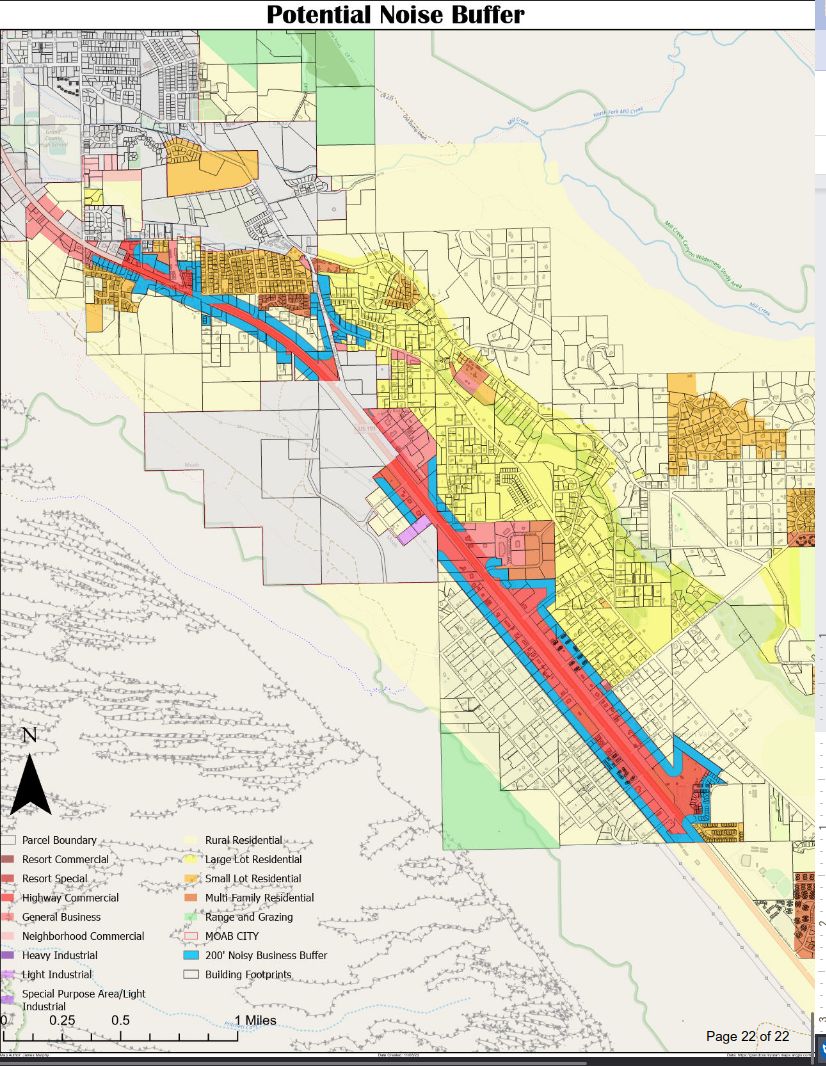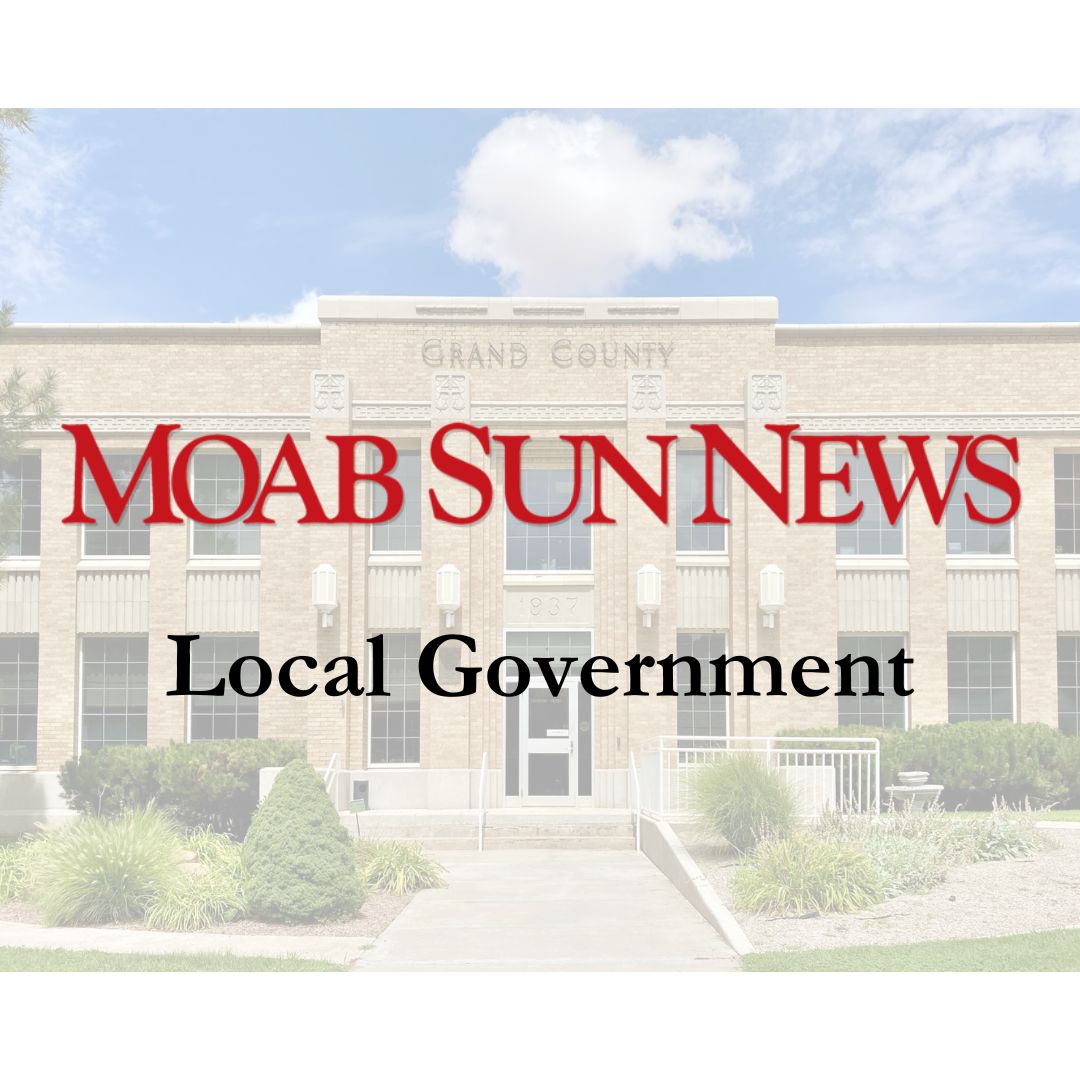Local business owners, especially UTV guide and rental companies, were alarmed by a Grand County Planning Commission Nov. 28 agenda item considering a proposed change to the county’s land use code. The amendment would establish a 200-foot noise buffer zone between adjacent residential and highway commercial properties, as well as an overlay map identifying appropriate locations for future UTV outfitter businesses. The proposal is still in draft form and has to go through more revisions, public hearings and discussions; it also would only apply to new businesses, or to existing businesses that make substantial expansions. However, business owners said they felt blindsided by the proposal and, even after assurances that their operations would not be affected, had concerns about potential future implications and about the county’s attitude toward their industry.
Growing conflict
“If you look at our zoning map, you can see the Highway Commercial zoning is all along Highway 191 in the south corridor,” said Planning Director Elissa Martin. “When that map was created decades ago, there was not really any consideration of providing any kind of buffer between Highway Commercial and residential zoning… This is creating a lot of problems for those residences and those neighborhoods in terms of noise and the impacts to their public health, safety and welfare.”
Grand County Commissioner Trisha Hedin, who serves as a liaison to the Planning Commission, said officials have received many complaints about noise from a dog kennel business, for example.
Martin said the concept of addressing conflicts in areas where commercial and residential zones meet has been in the works for almost a year; the county’s intention is to use careful planning to prevent more conflict between future developments.
The draft ordinance that would approve the amendments mentions, in addition to residential neighborhoods, schools, churches, parks and playgrounds as places to be protected from noise and other commercial impacts.
The revised land use code would only apply to new businesses in the county (not within Moab City limits).
Proposed changes
Some of the proposed changes to the land use code are organizational: for example, planners moved regulations regarding hotels into the “overnight accommodations” section of the land use code, and regulations about flea markets were identified as a temporary use.
Significant proposed changes include a new section in Article 6 (General Development Standards) outlining noise mitigation standards for businesses that produce noise. A detailed definition of noise-producing businesses is still in the process of being drafted, but the land use code amendments considered at the Nov. 28 meeting do reference auto repair and car wash businesses; bars and taverns; outfitters; conference and event centers; and kennels and dog-boarding facilities as noise-generating businesses.
The noise mitigation section requires businesses of these kinds to have a 200-foot buffer between the business and adjacent residentially-zoned properties, as well as schools, churches, parks and playgrounds. If the buffer is not met, the business will have to construct an 8 foot noise buffering wall or a row of trees (for certain kinds of outfitters, the draft specifies that an impervious wall, rather than trees, must be installed). Martin noted that many businesses within the identified zones already have a 200-foot buffer between their operations and neighboring residential properties.
There are also draft guidelines for specific types of businesses. New UTV guide and outfitter businesses, as well as new auto-repair shops, would also be required to install and maintain dust-proof surfaces for vehicle storage, parking, loading and unloading. Kennels and dog-boarding facilities would have to meet minimum lot size requirements, have indoor spaces for dog care and boarding, and allow dogs outside only during non-restricted hours under the noise pollution code, among other requirements.
Outfitter B Overlay
Another significant proposed change to the land use code would create an overlay map specifying locations where certain kinds of new UTV outfitters could open.
A proposed, but not yet approved, classification system for outfitters sorts them into groups A through D. (Approval of these definitions will be considered separately from consideration of the land use code changes discussed at the meeting). The first group, A, is defined as outfitters that trailer their vehicles to trailheads or that have all-electric fleets. Outfitter B businesses offer guided all-terrain vehicle tours and do not trailer their vehicles to trailheads. Outfitter C businesses rent or offer tours in motorized vehicles other than ATV/UTVs; Outfitter D operations are primarily nonmotorized guide services such as horseback riding or mountain biking, with paramotor and sky tours included.
New “outfitter B” businesses would be restricted to locations identified on an overlay map “where their impacts to surrounding neighborhoods are minimized.” Appropriate locations are described in the draft as close to off-road trailheads so that vehicles don’t have to travel through residential neighborhoods to reach them; having main ingress and egress on an arterial street; and being outside of residential or commercial buffer zones or along Highway 128 (River Road). However, as several commenters pointed out, those parameters leave no real locations available for such businesses: there are no arterial streets located next to the most popular off-road trailheads, which are generally in the Sand Flats Recreation Area and off of Kane Creek Boulevard.
Concerns
Over a dozen members of the public, mostly ATV/UTV outfitter business owners, attended the meeting virtually or in person to seek clarification and express their discomfort with the proposals. Mike McCurdy, who was elected to the Grand County Commission this fall and will begin serving in January, was among commenters who characterized the proposals as oppressive to small local businesses.
Many commenters wished the county had notified them earlier that code changes affecting their industries were in the works. While county officials emphasized repeatedly that the rules would apply only to new businesses, several business owners described having changed location multiple times over years of operation, and worried that they would have to comply with the new rules if they had to move again. Some business owners rent their properties, and had concerns about potential changes to the dynamics of their tenant/landlord relationships.
Dave Hellman, owner of Xtreme 4×4 tours, took issue with the draft categories of outfitters. Trailering UTVs to trailheads as described in Outfitter A businesses, he said, is unrealistic: he expects that large, expensive trailers driving through neighborhoods to and from trailheads will create bigger congestion and safety problems than tour groups of UTVs; he also said there’s not enough room either at trailheads or on business premises to store large trailers.
Jennifer Johnson, owner of Epic 4×4 Adventures, highlighted the parameters of the Outfitter B Overlay: where could a new outfitter business locate and still meet those rules? she asked.
“We don’t see any path to compliance at all,” Johnson said.
Other commenters said the costs of the dust and noise mitigation measures outlined in the draft amendments would prevent small businesses from getting started—leaving opportunities only for large, impersonal businesses to open.
“Everything that I see that keeps happening, is trying to invite big business—giant business—because they’re the ones who can afford it,” said Jason Parriott, who has owned businesses in Moab for decades. “Keep in mind, this is your neighbors you’re talking about—your future neighbors.”
The common sentiment running through comments was a feeling being left out or targeted. Business owners said they felt terrified, attacked, and overburdened; they asked to be included earlier on in the process for plans affecting their industries.
“This is a good opportunity to pause and collaborate with the community,” said Nick Oldham, a guide with High Point Hummer.
Next steps
The Planning Commission agreed with commenters that several points in the proposed changes needed clarification; Martin acknowledged that the parameters of the Outfitter B Overlay, for example, were not realistic. The body voted unanimously to postpone the item until the next meeting. When the planning commission does vote on the draft changes, they will only be voting on what kind of recommendation to pass along to the county commission: an unfavorable recommendation, a favorable recommendation, or a favorable recommendation with a list of items that need further clarification.
Once the Planning Commission has made its recommendation, the changes will undergo another public hearing with the Grand County Commission, and that body will discuss the proposals and ultimately vote on whether to adopt them; there may be more revisions made throughout the process.
The draft changes to the land use code can be found in the Nov. 28 Planning Commission agenda packet on the county’s website (grandcountyutah.net). Comments may still be emailed to the Planning Commission through a link on the Grand County website: grandcountyutah.net/209/Planning-Commission. Comments to the Grand County Commission can be emailed to commission@grandcountyutah.net.




